Abstract
Veterinary diagnostic microbiology is a unique specialty within microbiology. Although isolation and identification techniques are similar to those used for human pathogens, many veterinary pathogens require unique cultivation or identification procedures. Commercial identification systems provide rapid, accurate identification of human pathogens. However, the accuracy of these systems with veterinary pathogens varies widely depending on the bacterial species and the host animal from which it was isolated. Increased numbers of veterinary strains or species in the data bases of the various systems would improve their accuracy. Current procedures and interpretive criteria used for antimicrobial susceptibility testing of veterinary pathogens are based on guidelines used for human pathogens. The validity of these guidelines for use with veterinary pathogens has not been established. As with fastidious human pathogens, standardized methodologies and quality control isolates are needed for tests of organisms such as Actinobacillus pleuropneumoniae and Haemophilus somnus. Furthermore, interpretive criteria for veterinary antimicrobial agents based on the MIC for veterinary pathogens, the pharmacokinetics of the antimicrobial agent in the host animal, and in vivo efficacy of the antimicrobial agent are needed. This article reviews both the commercial identification systems evaluated with veterinary pathogens and current methods for performing and interpreting antimicrobial susceptibility tests with veterinary pathogens. Recommendations for future improvements in both areas are discussed.
Full text
PDF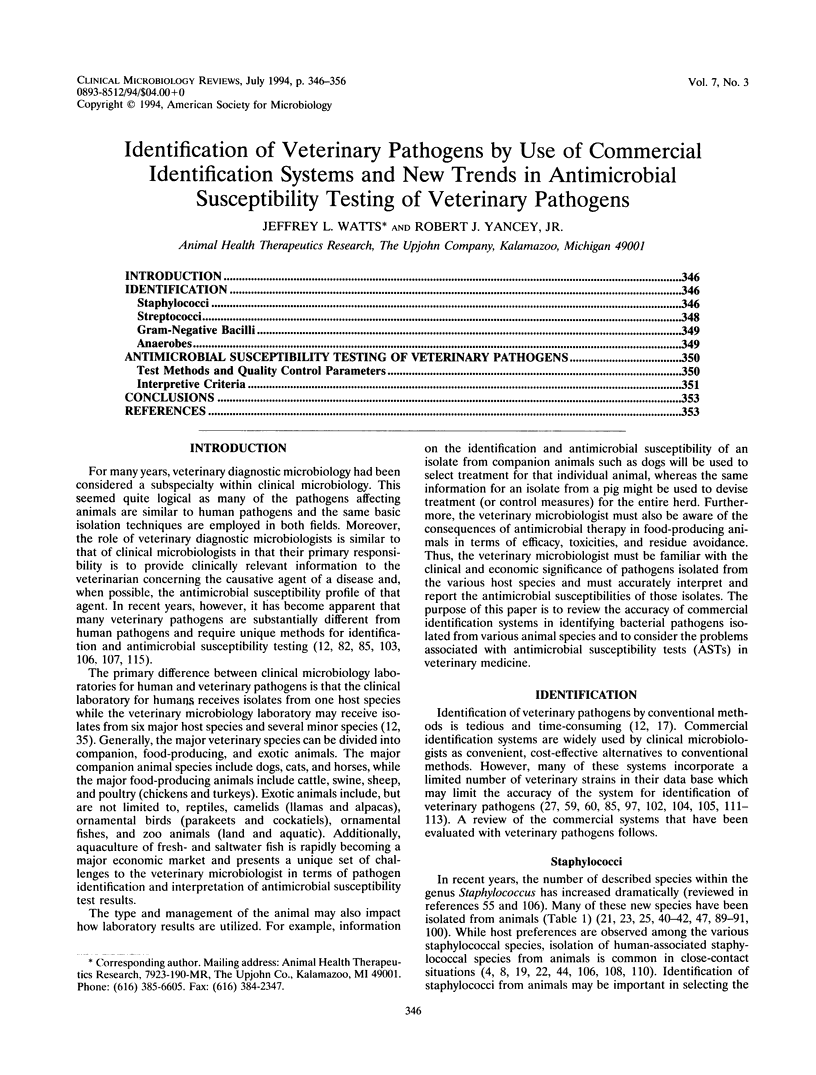
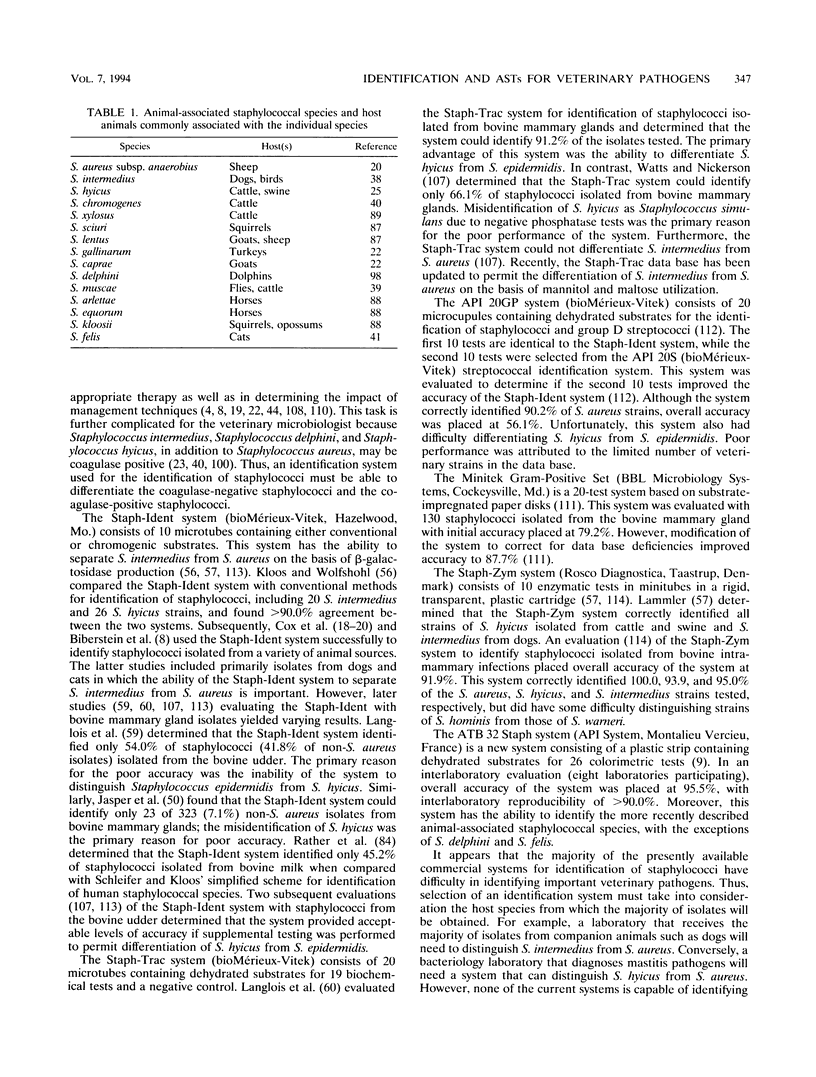
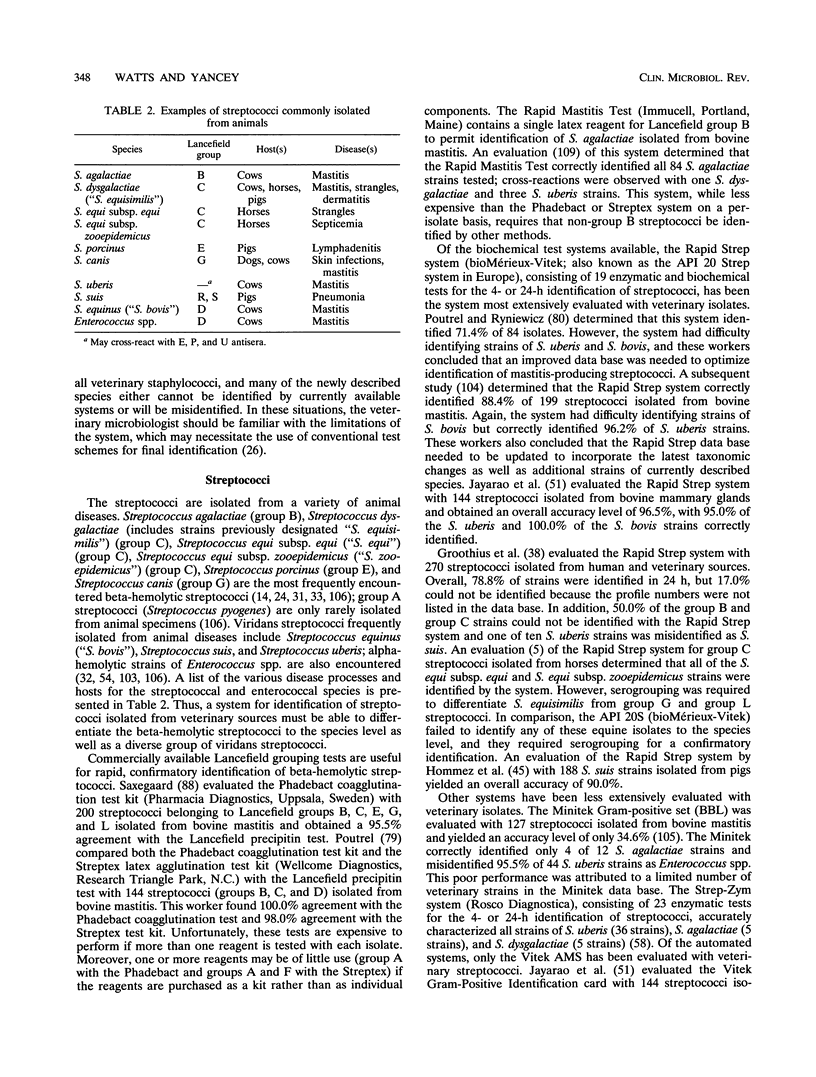
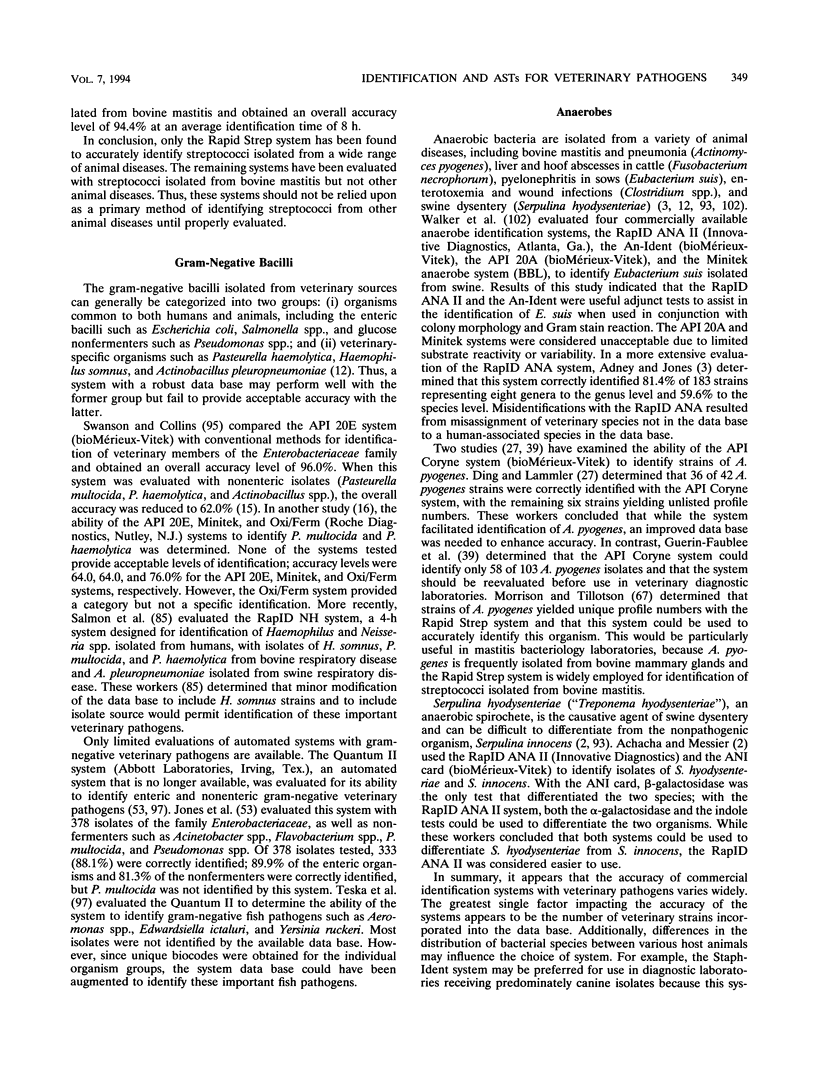
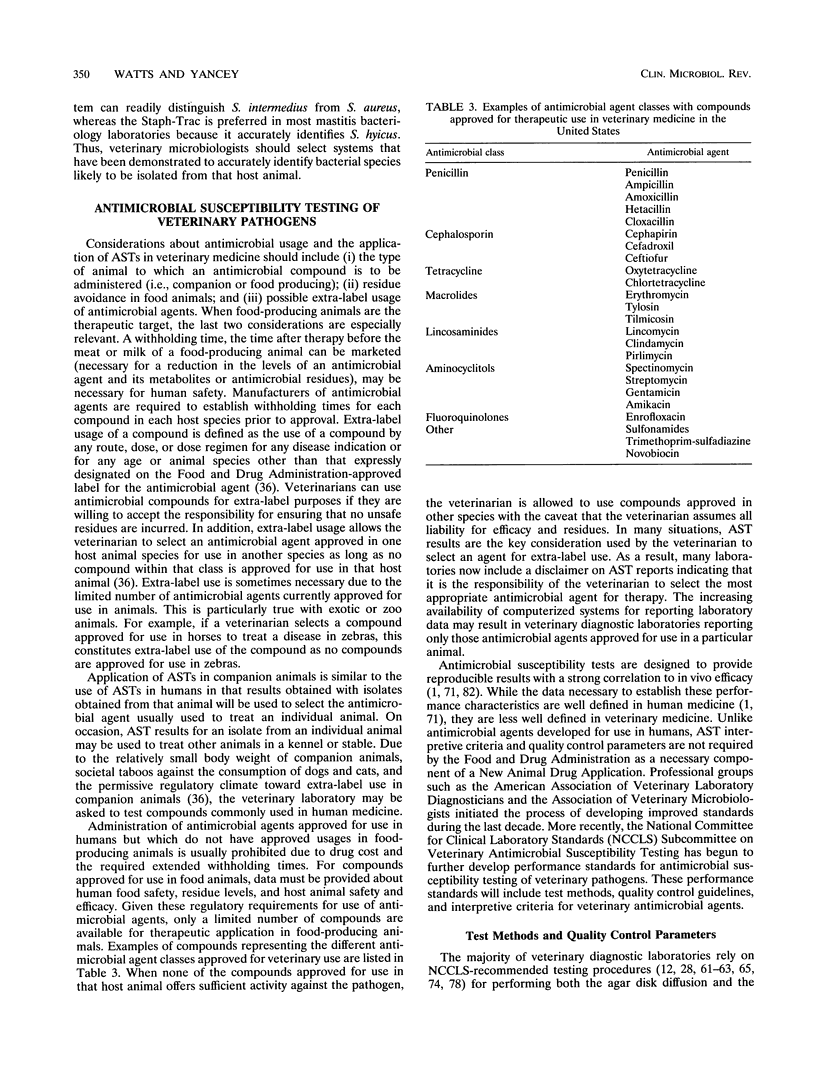
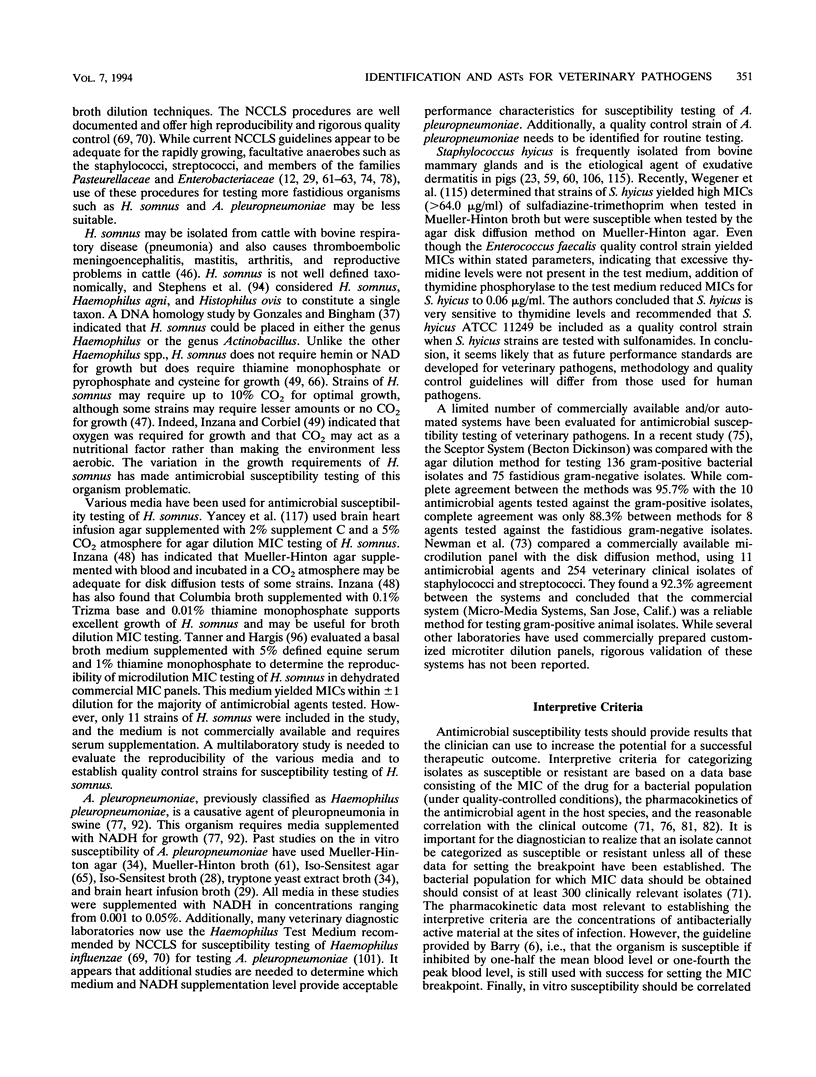

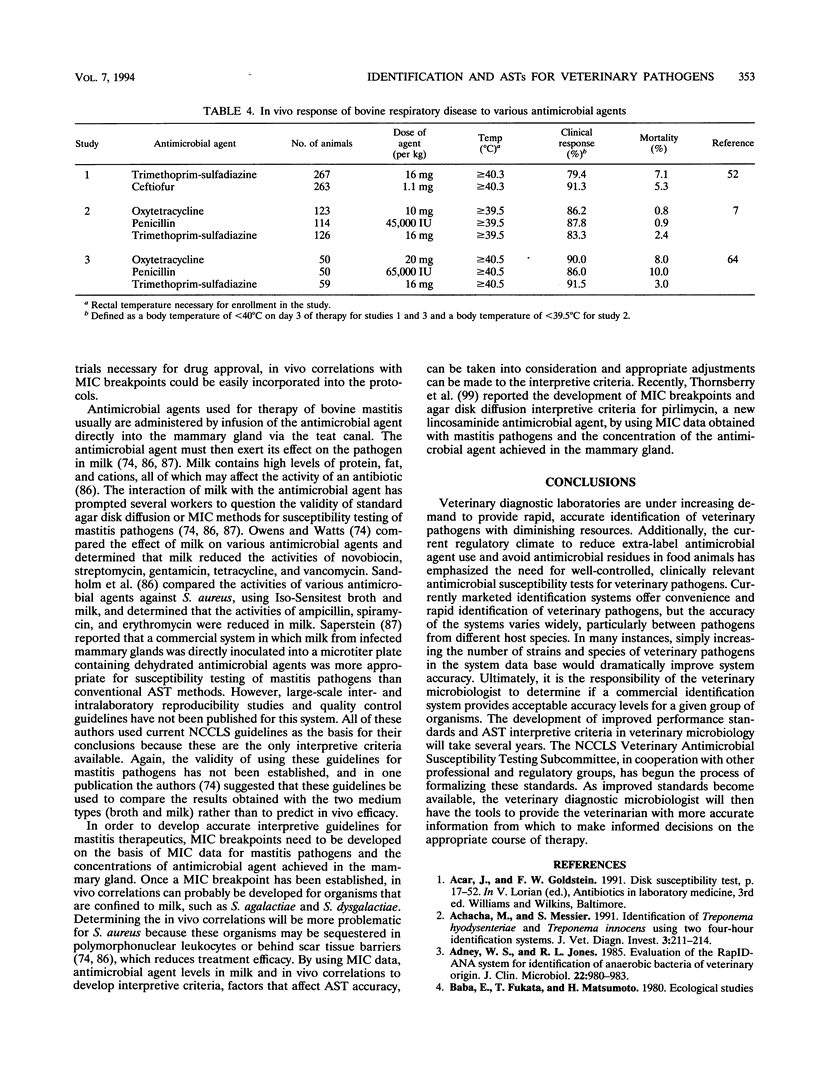
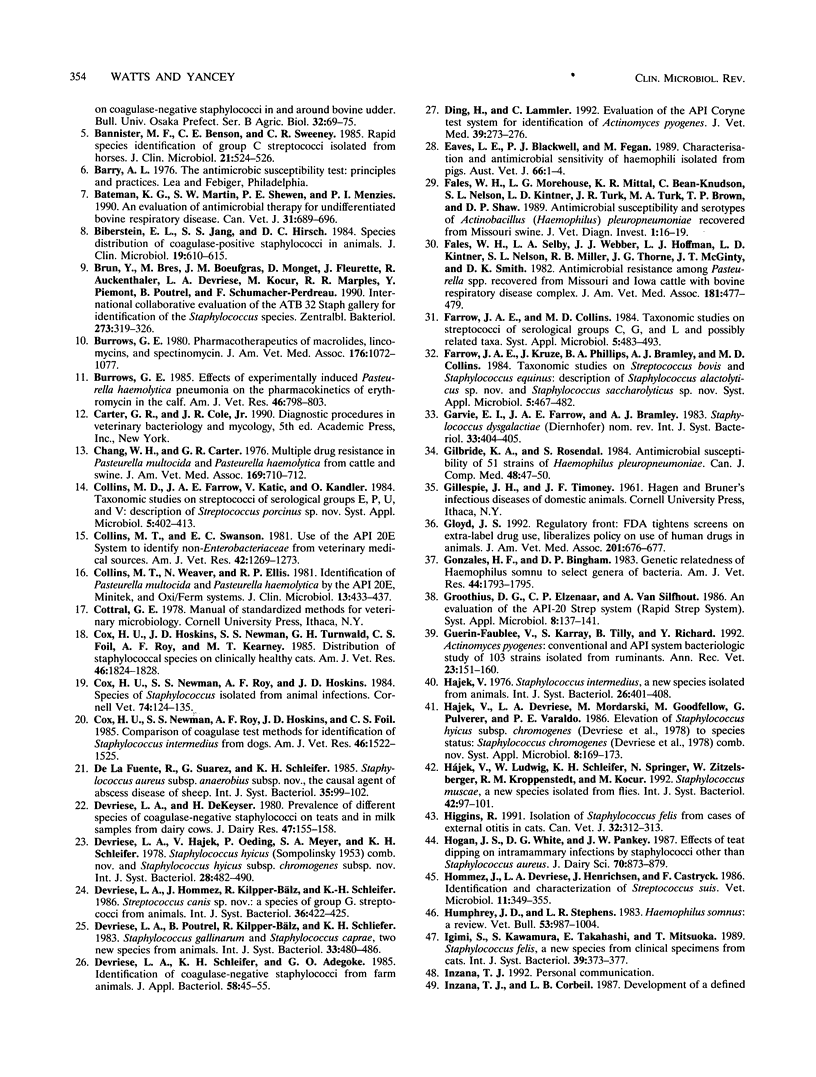
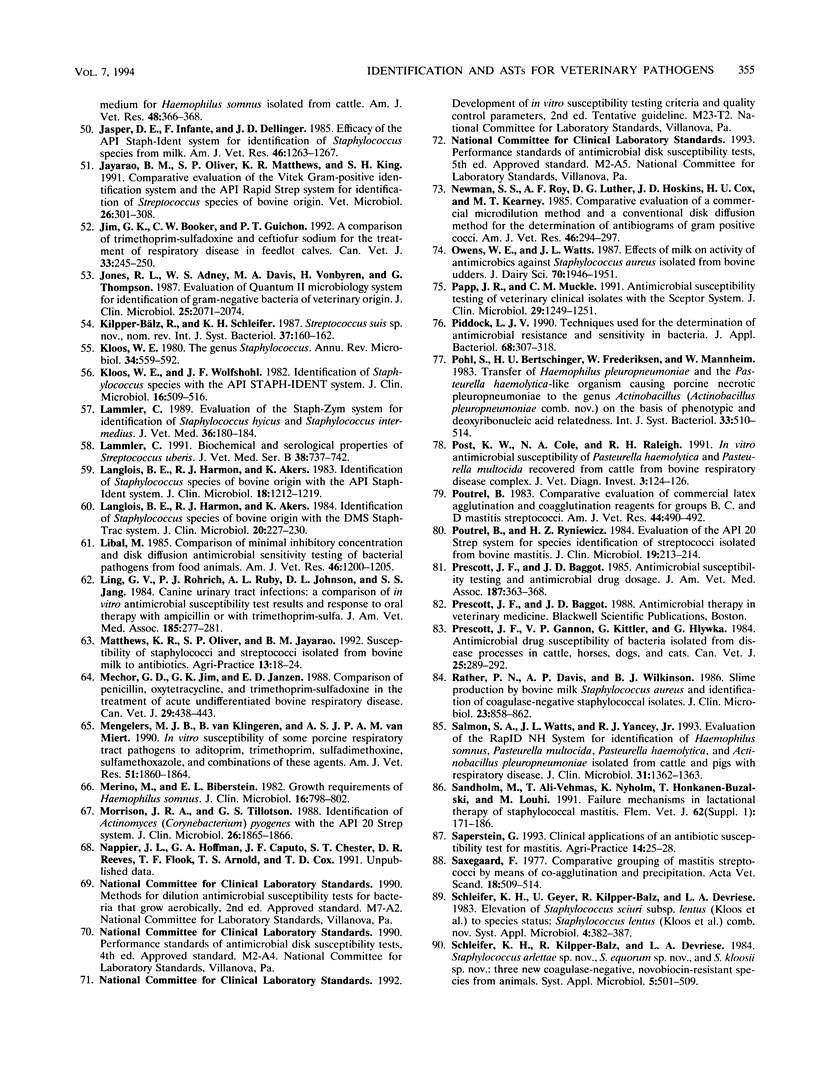
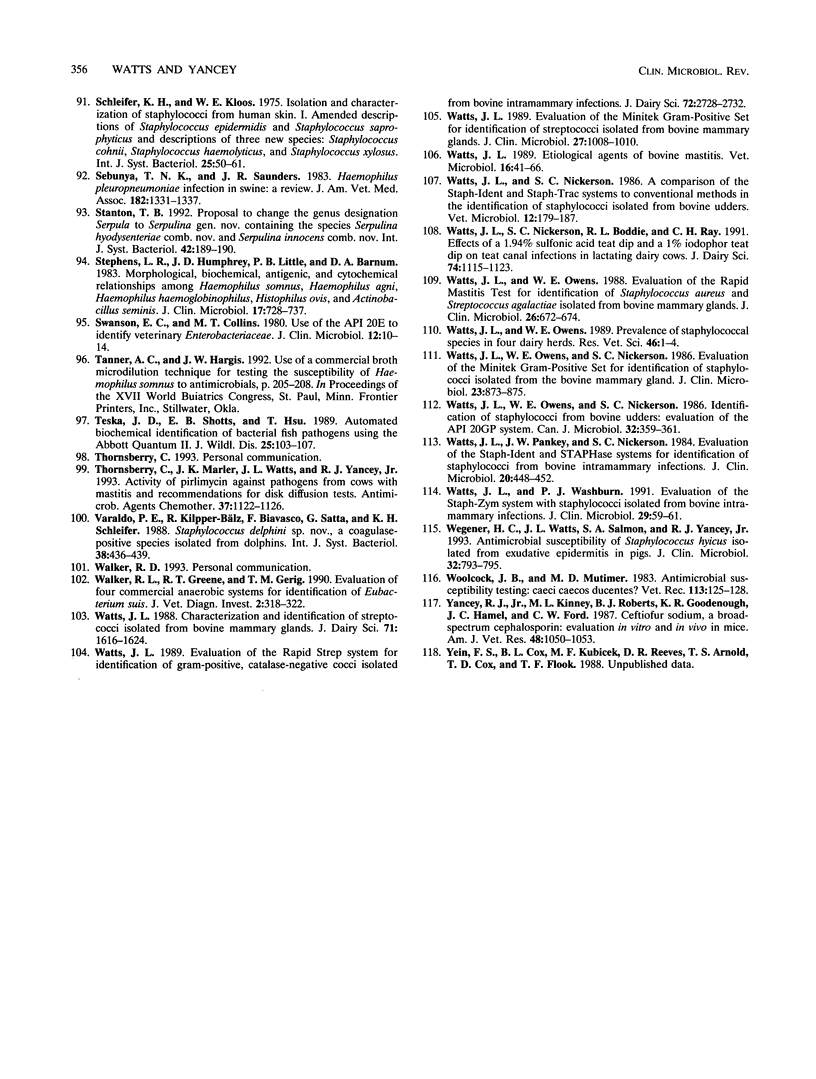
Selected References
These references are in PubMed. This may not be the complete list of references from this article.
- Achacha M., Messier S. Identification of Treponema hyodysenteriae and Treponema innocens using two four-hour identification systems. J Vet Diagn Invest. 1991 Jul;3(3):211–214. doi: 10.1177/104063879100300304. [DOI] [PubMed] [Google Scholar]
- Adney W. S., Jones R. L. Evaluation of the RapID-ANA system for identification of anaerobic bacteria of veterinary origin. J Clin Microbiol. 1985 Dec;22(6):980–983. doi: 10.1128/jcm.22.6.980-983.1985. [DOI] [PMC free article] [PubMed] [Google Scholar]
- Bannister M. F., Benson C. E., Sweeney C. R. Rapid species identification of group C streptococci isolated from horses. J Clin Microbiol. 1985 Apr;21(4):524–526. doi: 10.1128/jcm.21.4.524-526.1985. [DOI] [PMC free article] [PubMed] [Google Scholar]
- Bateman K. G., Martin S. W., Shewen P. E., Menzies P. I. An evaluation of antimicrobial therapy for undifferentiated bovine respiratory disease. Can Vet J. 1990 Oct;31(10):689–696. [PMC free article] [PubMed] [Google Scholar]
- Biberstein E. L., Jang S. S., Hirsh D. C. Species distribution of coagulase-positive staphylococci in animals. J Clin Microbiol. 1984 May;19(5):610–615. doi: 10.1128/jcm.19.5.610-615.1984. [DOI] [PMC free article] [PubMed] [Google Scholar]
- Brun Y., Bes M., Boeufgras J. M., Monget D., Fleurette J., Auckenthaler R., Devriese L. A., Kocur M., Marples R. R., Piemont Y. International collaborative evaluation of the ATB 32 staph gallery for identification of the Staphylococcus species. Zentralbl Bakteriol. 1990 Aug;273(3):319–326. doi: 10.1016/s0934-8840(11)80435-4. [DOI] [PubMed] [Google Scholar]
- Burrows G. E. Effects of experimentally induced Pasteurella haemolytica pneumonia on the pharmacokinetics of erythromycin in the calf. Am J Vet Res. 1985 Apr;46(4):798–803. [PubMed] [Google Scholar]
- Burrows G. E. Pharmacotherapeutics of macrolides, lincomycins, and spectinomycin. J Am Vet Med Assoc. 1980 May 15;176(10 Spec No):1072–1077. [PubMed] [Google Scholar]
- Chang W. H., Carter G. R. Multiple drug resistance in Pasteurella multocida and Pasteurella haemolytica from cattle and swine. J Am Vet Med Assoc. 1976 Oct 1;169(7):710–712. [PubMed] [Google Scholar]
- Collins M. T., Swanson E. C. Use of the API 20E system to identify non-Enterobacteriaceae from veterinary medical sources. Am J Vet Res. 1981 Jul;42(7):1269–1273. [PubMed] [Google Scholar]
- Collins M. T., Weaver N., Ellis R. P. Identification of Pasteurella multocida and Pasteurella haemolytica by API 20E, Minitek, and Oxi/Ferm systems. J Clin Microbiol. 1981 Mar;13(3):433–437. doi: 10.1128/jcm.13.3.433-437.1981. [DOI] [PMC free article] [PubMed] [Google Scholar]
- Cox H. U., Hoskins J. D., Newman S. S., Turnwald G. H., Foil C. S., Roy A. F., Kearney M. T. Distribution of staphylococcal species on clinically healthy cats. Am J Vet Res. 1985 Sep;46(9):1824–1828. [PubMed] [Google Scholar]
- Cox H. U., Newman S. S., Roy A. F., Hoskins J. D., Foil C. S. Comparison of coagulase test methods for identification of Staphylococcus intermedius from dogs. Am J Vet Res. 1985 Jul;46(7):1522–1525. [PubMed] [Google Scholar]
- Cox H. U., Newman S. S., Roy A. F., Hoskins J. D. Species of Staphylococcus isolated from animal infections. Cornell Vet. 1984 Apr;74(2):124–135. [PubMed] [Google Scholar]
- Devriese L. A., De Keyser H. Prevalence of different species of coagulase-negative staphylococci on teats and in milk samples from dairy cows. J Dairy Res. 1980 Feb;47(1):155–158. doi: 10.1017/s0022029900020999. [DOI] [PubMed] [Google Scholar]
- Devriese L. A., Schleifer K. H., Adegoke G. O. Identification of coagulase-negative staphylococci from farm animals. J Appl Bacteriol. 1985 Jan;58(1):45–55. doi: 10.1111/j.1365-2672.1985.tb01428.x. [DOI] [PubMed] [Google Scholar]
- Ding H., Lämmler C. Evaluation of the API Coryne test system for identification of Actinomyces pyogenes. Zentralbl Veterinarmed B. 1992 Jun;39(4):273–276. doi: 10.1111/j.1439-0450.1992.tb01168.x. [DOI] [PubMed] [Google Scholar]
- Eaves L. E., Blackall P. J., Fegan M. Characterisation and antimicrobial sensitivity of haemophili isolated from pigs. Aust Vet J. 1989 Jan;66(1):1–4. doi: 10.1111/j.1751-0813.1989.tb09701.x. [DOI] [PubMed] [Google Scholar]
- Fales W. H., Morehouse L. G., Mittal K. R., Bean-Knudsen C., Nelson S. L., Kintner L. D., Turk J. R., Turk M. A., Brown T. P., Shaw D. P. Antimicrobial susceptibility and serotypes of Actinobacillus (Haemophilus) pleuropneumoniae recovered from Missouri swine. J Vet Diagn Invest. 1989 Jan;1(1):16–19. doi: 10.1177/104063878900100106. [DOI] [PubMed] [Google Scholar]
- Fales W. H., Selby L. A., Webber J. J., Hoffman L. J., Kintner L. D., Nelson S. L., Miller R. B., Thorne J. G., McGinity J. T., Smith D. K. Antimicrobial resistance among Pasteurella spp recovered from Missouri and Iowa cattle with bovine respiratory disease complex. J Am Vet Med Assoc. 1982 Sep 1;181(5):477–479. [PubMed] [Google Scholar]
- Gilbride K. A., Rosendal S. Antimicrobial susceptibility of 51 strains of Haemophilus pleuropneumoniae. Can J Comp Med. 1984 Jan;48(1):47–50. [PMC free article] [PubMed] [Google Scholar]
- Gloyd J. S. FDA tightens screws on extra-label drug use, liberalizes policy on use of human drugs in animals. J Am Vet Med Assoc. 1992 Sep 1;201(5):676–677. [PubMed] [Google Scholar]
- Gonzales H. F., Bingham D. P. Genetic relatedness of Haemophilus somnus to select genera of bacteria. Am J Vet Res. 1983 Sep;44(9):1793–1795. [PubMed] [Google Scholar]
- Guérin-Faublée V., Karray S., Tilly B., Richard Y. Actinomyces pyogenes: étude bactériologique conventionnelle et sur galeries Api de 103 souches isolées chez les ruminants. Ann Rech Vet. 1992;23(2):151–160. [PubMed] [Google Scholar]
- Higgins R., Gottschalk M. Québec. Isolation of Staphylococcus felis from cases of external otitis in cats. Can Vet J. 1991 May;32(5):312–313. [PMC free article] [PubMed] [Google Scholar]
- Hogan J. S., White D. G., Pankey J. W. Effects of teat dipping on intramammary infections by staphylococci other than Staphylococcus aureus. J Dairy Sci. 1987 Apr;70(4):873–879. doi: 10.3168/jds.S0022-0302(87)80086-3. [DOI] [PubMed] [Google Scholar]
- Hommez J., Devriese L. A., Henrichsen J., Castryck F. Identification and characterization of Streptococcus suis. Vet Microbiol. 1986 Apr;11(4):349–355. doi: 10.1016/0378-1135(86)90065-9. [DOI] [PubMed] [Google Scholar]
- Hájek V., Ludwig W., Schleifer K. H., Springer N., Zitzelsberger W., Kroppenstedt R. M., Kocur M. Staphylococcus muscae, a new species isolated from flies. Int J Syst Bacteriol. 1992 Jan;42(1):97–101. doi: 10.1099/00207713-42-1-97. [DOI] [PubMed] [Google Scholar]
- Inzana T. J., Corbeil L. B. Development of a defined medium for Haemophilus somnus isolated from cattle. Am J Vet Res. 1987 Mar;48(3):366–369. [PubMed] [Google Scholar]
- Jasper D. E., Infante F., Dellinger J. D. Efficacy of the API Staph-Ident system for identification of Staphylococcus species from milk. Am J Vet Res. 1985 Jun;46(6):1263–1267. [PubMed] [Google Scholar]
- Jayarao B. M., Oliver S. P., Matthews K. R., King S. H. Comparative evaluation of Vitek gram-positive identification system and API Rapid Strep system for identification of Streptococcus species of bovine origin. Vet Microbiol. 1991 Feb 1;26(3):301–308. doi: 10.1016/0378-1135(91)90023-9. [DOI] [PubMed] [Google Scholar]
- Jim G. K., Booker C. W., Guichon P. T. A comparison of trimethoprim-sulfadoxine and ceftiofur sodium for the treatment of respiratory disease in feedlot calves. Can Vet J. 1992 Apr;33(4):245–250. [PMC free article] [PubMed] [Google Scholar]
- Jones R. L., Adney W. S., Davis M. A., Vonbyren H., Thompson G. Evaluation of Quantum II microbiology system for identification of gram-negative bacteria of veterinary origin. J Clin Microbiol. 1987 Nov;25(11):2071–2074. doi: 10.1128/jcm.25.11.2071-2074.1987. [DOI] [PMC free article] [PubMed] [Google Scholar]
- Kloos W. E. Natural populations of the genus Staphylococcus. Annu Rev Microbiol. 1980;34:559–592. doi: 10.1146/annurev.mi.34.100180.003015. [DOI] [PubMed] [Google Scholar]
- Kloos W. E., Wolfshohl J. F. Identification of Staphylococcus species with the API STAPH-IDENT system. J Clin Microbiol. 1982 Sep;16(3):509–516. doi: 10.1128/jcm.16.3.509-516.1982. [DOI] [PMC free article] [PubMed] [Google Scholar]
- Langlois B. E., Harmon R. J., Akers K. Identification of Staphylococcus species of bovine origin with the API Staph-Ident system. J Clin Microbiol. 1983 Nov;18(5):1212–1219. doi: 10.1128/jcm.18.5.1212-1219.1983. [DOI] [PMC free article] [PubMed] [Google Scholar]
- Langlois B. E., Harmon R. J., Akers K. Identification of Staphylococcus species of bovine origin with the DMS Staph-Trac system. J Clin Microbiol. 1984 Aug;20(2):227–230. doi: 10.1128/jcm.20.2.227-230.1984. [DOI] [PMC free article] [PubMed] [Google Scholar]
- Libal M. C. Comparison of minimal inhibitory concentration and disk-diffusion antimicrobic sensitivity testing of bacterial pathogens isolated from food animals. Am J Vet Res. 1985 May;46(5):1200–1205. [PubMed] [Google Scholar]
- Ling G. V., Rohrich P. J., Ruby A. L., Johnson D. L., Jang S. S. Canine urinary tract infections: a comparison of in vitro antimicrobial susceptibility test results and response to oral therapy with ampicillin or with trimethoprim-sulfa. J Am Vet Med Assoc. 1984 Aug 1;185(3):277–281. [PubMed] [Google Scholar]
- Lämmler C. Biochemical and serological properties of Streptococcus uberis. Zentralbl Veterinarmed B. 1991 Dec;38(10):737–742. doi: 10.1111/j.1439-0450.1991.tb00937.x. [DOI] [PubMed] [Google Scholar]
- Lämmler C. Evaluation of the Staph-Zym-system for identification of Staphylococcus hyicus and Staphylococcus intermedius. Zentralbl Veterinarmed B. 1989 May;36(3):180–184. doi: 10.1111/j.1439-0450.1989.tb00589.x. [DOI] [PubMed] [Google Scholar]
- Mechor G. D., Jim G. K., Janzen E. D. Comparison of penicillin, oxytetracycline, and trimethoprim-sulfadoxine in the treatment of acute undifferentiated bovine respiratory disease. Can Vet J. 1988 May;29(5):438–443. [PMC free article] [PubMed] [Google Scholar]
- Mengelers M. J., van Klingeren B., van Miert A. S. In vitro susceptibility of some porcine respiratory tract pathogens to aditoprim, trimethoprim, sulfadimethoxine, sulfamethoxazole, and combinations of these agents. Am J Vet Res. 1990 Nov;51(11):1860–1864. [PubMed] [Google Scholar]
- Merino M., Biberstein E. L. Growth requirements of Haemophilus somnus. J Clin Microbiol. 1982 Nov;16(5):798–802. doi: 10.1128/jcm.16.5.798-802.1982. [DOI] [PMC free article] [PubMed] [Google Scholar]
- Morrison J. R., Tillotson G. S. Identification of Actinomyces (Corynebacterium) pyogenes with the API 20 Strep system. J Clin Microbiol. 1988 Sep;26(9):1865–1866. doi: 10.1128/jcm.26.9.1865-1866.1988. [DOI] [PMC free article] [PubMed] [Google Scholar]
- Newman S. S., Roy A. F., Luther D. G., Hoskins J. D., Cox H. U., Kearney M. T. Comparative evaluation of a commercial microdilution method and a conventional disk diffusion method for determination of antibiograms of gram-positive cocci. Am J Vet Res. 1985 Jan;46(1):294–297. [PubMed] [Google Scholar]
- Owens W. E., Watts J. L. Effects of milk on activity of antimicrobics against Staphylococcus aureus isolated from bovine udders. J Dairy Sci. 1987 Sep;70(9):1946–1951. doi: 10.3168/jds.S0022-0302(87)80236-9. [DOI] [PubMed] [Google Scholar]
- Papp J. R., Muckle C. A. Antimicrobial susceptibility testing of veterinary clinical isolates with the Sceptor System. J Clin Microbiol. 1991 Jun;29(6):1249–1251. doi: 10.1128/jcm.29.6.1249-1251.1991. [DOI] [PMC free article] [PubMed] [Google Scholar]
- Piddock L. J. Techniques used for the determination of antimicrobial resistance and sensitivity in bacteria. Antimicrobial Agents Research Group. J Appl Bacteriol. 1990 Apr;68(4):307–318. doi: 10.1111/j.1365-2672.1990.tb02880.x. [DOI] [PubMed] [Google Scholar]
- Post K. W., Cole N. A., Raleigh R. H. In vitro antimicrobial susceptibility of Pasteurella haemolytica and Pasteurella multocida recovered from cattle with bovine respiratory disease complex. J Vet Diagn Invest. 1991 Apr;3(2):124–126. doi: 10.1177/104063879100300203. [DOI] [PubMed] [Google Scholar]
- Poutrel B. Comparative evaluation of commercial latex agglutination and coagglutination reagents for groups B, C, and D mastitis streptococci. Am J Vet Res. 1983 Mar;44(3):490–492. [PubMed] [Google Scholar]
- Poutrel B., Ryniewicz H. Z. Evaluation of the API 20 Strep system for species identification of streptococci isolated from bovine mastitis. J Clin Microbiol. 1984 Feb;19(2):213–214. doi: 10.1128/jcm.19.2.213-214.1984. [DOI] [PMC free article] [PubMed] [Google Scholar]
- Prescott J. F., Baggot J. D. Antimicrobial susceptibility testing and antimicrobial drug dosage. J Am Vet Med Assoc. 1985 Aug 15;187(4):363–368. [PubMed] [Google Scholar]
- Prescott J. F., Gannon V. P., Kittler G., Hlywka G. Antimicrobial drug susceptibility of bacteria isolated from disease processes in cattle, horses, dogs and cats. Can Vet J. 1984 Jul;25(7):289–292. [PMC free article] [PubMed] [Google Scholar]
- Rather P. N., Davis A. P., Wilkinson B. J. Slime production by bovine milk Staphylococcus aureus and identification of coagulase-negative staphylococcal isolates. J Clin Microbiol. 1986 May;23(5):858–862. doi: 10.1128/jcm.23.5.858-862.1986. [DOI] [PMC free article] [PubMed] [Google Scholar]
- Salmon S. A., Watts J. L., Yancey R. J., Jr Evaluation of the RapID NH system for identification of Haemophilus somnus, Pasteurella multocida, Pasteurella haemolytica, and Actinobacillus pleuropneumoniae isolated from cattle and pigs with respiratory disease. J Clin Microbiol. 1993 May;31(5):1362–1363. doi: 10.1128/jcm.31.5.1362-1363.1993. [DOI] [PMC free article] [PubMed] [Google Scholar]
- Saxegaard F. Comparative grouping of mastitis Streptococci by means of co-agglutination and precipitation. Acta Vet Scand. 1977;18(4):509–514. doi: 10.1186/BF03548414. [DOI] [PMC free article] [PubMed] [Google Scholar]
- Sebunya T. N., Saunders J. R. Haemophilus pleuropneumoniae infection in swine: a review. J Am Vet Med Assoc. 1983 Jun 15;182(12):1331–1337. [PubMed] [Google Scholar]
- Stanton T. B. Proposal to change the genus designation Serpula to Serpulina gen. nov. containing the species Serpulina hyodysenteriae comb. nov. and Serpulina innocens comb. nov. Int J Syst Bacteriol. 1992 Jan;42(1):189–190. doi: 10.1099/00207713-42-1-189. [DOI] [PubMed] [Google Scholar]
- Stephens L. R., Humphrey J. D., Little P. B., Barnum D. A. Morphological, biochemical, antigenic, and cytochemical relationships among Haemophilus somnus, Haemophilus agni, Haemophilus haemoglobinophilus, Histophilus ovis, and Actinobacillus seminis. J Clin Microbiol. 1983 May;17(5):728–737. doi: 10.1128/jcm.17.5.728-737.1983. [DOI] [PMC free article] [PubMed] [Google Scholar]
- Swanson E. C., Collins M. T. Use of the API 20E system to identify veterinary Enterobacteriaceae. J Clin Microbiol. 1980 Jul;12(1):10–14. doi: 10.1128/jcm.12.1.10-14.1980. [DOI] [PMC free article] [PubMed] [Google Scholar]
- Teska J. D., Shotts E. B., Hsu T. Automated biochemical identification of bacterial fish pathogens using the Abbott Quantum II. J Wildl Dis. 1989 Jan;25(1):103–107. doi: 10.7589/0090-3558-25.1.103. [DOI] [PubMed] [Google Scholar]
- Thornsberry C., Marler J. K., Watts J. L., Yancey R. J., Jr Activity of pirlimycin against pathogens from cows with mastitis and recommendations for disk diffusion tests. Antimicrob Agents Chemother. 1993 May;37(5):1122–1126. doi: 10.1128/aac.37.5.1122. [DOI] [PMC free article] [PubMed] [Google Scholar]
- Walker R. L., Greene R. T., Gerig T. M. Evaluation of four commercial anaerobic systems for identification of Eubacterium suis. J Vet Diagn Invest. 1990 Oct;2(4):318–322. doi: 10.1177/104063879000200412. [DOI] [PubMed] [Google Scholar]
- Watts J. L. Characterization and identification of streptococci isolated from bovine mammary glands. J Dairy Sci. 1988 Jun;71(6):1616–1624. doi: 10.3168/jds.S0022-0302(88)79725-8. [DOI] [PubMed] [Google Scholar]
- Watts J. L. Etiological agents of bovine mastitis. Vet Microbiol. 1988 Jan;16(1):41–66. doi: 10.1016/0378-1135(88)90126-5. [DOI] [PubMed] [Google Scholar]
- Watts J. L. Evaluation of the Minitek Gram-Positive Set for identification of streptococci isolated from bovine mammary glands. J Clin Microbiol. 1989 May;27(5):1008–1010. doi: 10.1128/jcm.27.5.1008-1010.1989. [DOI] [PMC free article] [PubMed] [Google Scholar]
- Watts J. L. Evaluation of the Rapid Strep system for identification of gram-positive, catalase-negative cocci isolated from bovine intramammary infections. J Dairy Sci. 1989 Oct;72(10):2728–2732. doi: 10.3168/jds.S0022-0302(89)79416-9. [DOI] [PubMed] [Google Scholar]
- Watts J. L., Nickerson S. C. A comparison of the STAPH-Ident and STAPH-Trac systems to conventional methods in the identification of staphylococci isolated from bovine udders. Vet Microbiol. 1986 Jul;12(2):179–187. doi: 10.1016/0378-1135(86)90079-9. [DOI] [PubMed] [Google Scholar]
- Watts J. L., Nickerson S. C., Boddie R. L., Ray C. H. Effects of a 1.94% sulfonic acid teat dip and a 1% iodophor teat dip on teat canal infections in lactating dairy cows. J Dairy Sci. 1991 Mar;74(3):1115–1123. doi: 10.3168/jds.S0022-0302(91)78263-5. [DOI] [PubMed] [Google Scholar]
- Watts J. L., Owens W. E. Evaluation of the Rapid Mastitis Test for identification of Staphylococcus aureus and Streptococcus agalactiae isolated from bovine mammary glands. J Clin Microbiol. 1988 Apr;26(4):672–674. doi: 10.1128/jcm.26.4.672-674.1988. [DOI] [PMC free article] [PubMed] [Google Scholar]
- Watts J. L., Owens W. E., Nickerson S. C. Evaluation of the Minitek gram-positive set for identification of staphylococci isolated from the bovine mammary gland. J Clin Microbiol. 1986 May;23(5):873–875. doi: 10.1128/jcm.23.5.873-875.1986. [DOI] [PMC free article] [PubMed] [Google Scholar]
- Watts J. L., Owens W. E., Nickerson S. C. Identification of staphylococci from bovine udders: evaluation of the API 20GP system. Can J Microbiol. 1986 Apr;32(4):359–361. doi: 10.1139/m86-069. [DOI] [PubMed] [Google Scholar]
- Watts J. L., Owens W. E. Prevalence of staphylococcal species in four dairy herds. Res Vet Sci. 1989 Jan;46(1):1–4. [PubMed] [Google Scholar]
- Watts J. L., Pankey J. W., Nickerson S. C. Evaluation of the Staph-Ident and STAPHase systems for identification of staphylococci from bovine intramammary infections. J Clin Microbiol. 1984 Sep;20(3):448–452. doi: 10.1128/jcm.20.3.448-452.1984. [DOI] [PMC free article] [PubMed] [Google Scholar]
- Watts J. L., Washburn P. J. Evaluation of the Staph-Zym system with staphylococci isolated from bovine intramammary infections. J Clin Microbiol. 1991 Jan;29(1):59–61. doi: 10.1128/jcm.29.1.59-61.1991. [DOI] [PMC free article] [PubMed] [Google Scholar]
- Wegener H. C., Watts J. L., Salmon S. A., Yancey R. J., Jr Antimicrobial susceptibility of Staphylococcus hyicus isolated from exudative epidermitis in pigs. J Clin Microbiol. 1994 Mar;32(3):793–795. doi: 10.1128/jcm.32.3.793-795.1994. [DOI] [PMC free article] [PubMed] [Google Scholar]
- Woolcock J. B., Mutimer M. D. Antibiotic susceptibility testing: caeci caecos ducentes? Vet Rec. 1983 Aug 6;113(6):125–128. doi: 10.1136/vr.113.6.125. [DOI] [PubMed] [Google Scholar]
- Yancey R. J., Jr, Kinney M. L., Roberts B. J., Goodenough K. R., Hamel J. C., Ford C. W. Ceftiofur sodium, a broad-spectrum cephalosporin: evaluation in vitro and in vivo in mice. Am J Vet Res. 1987 Jul;48(7):1050–1053. [PubMed] [Google Scholar]


